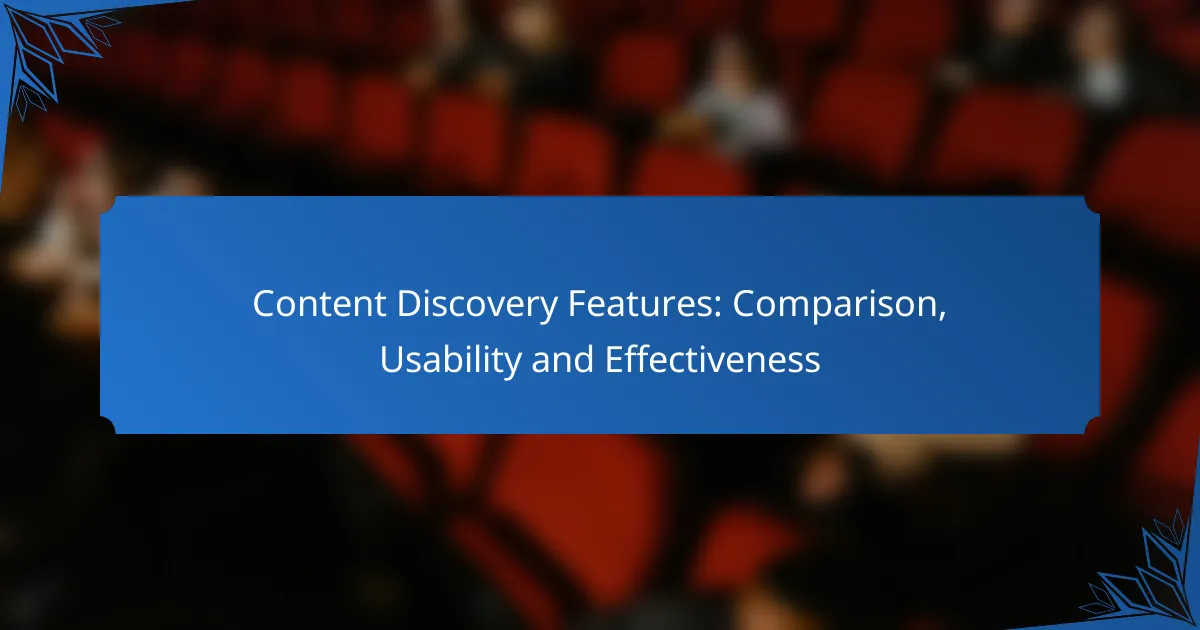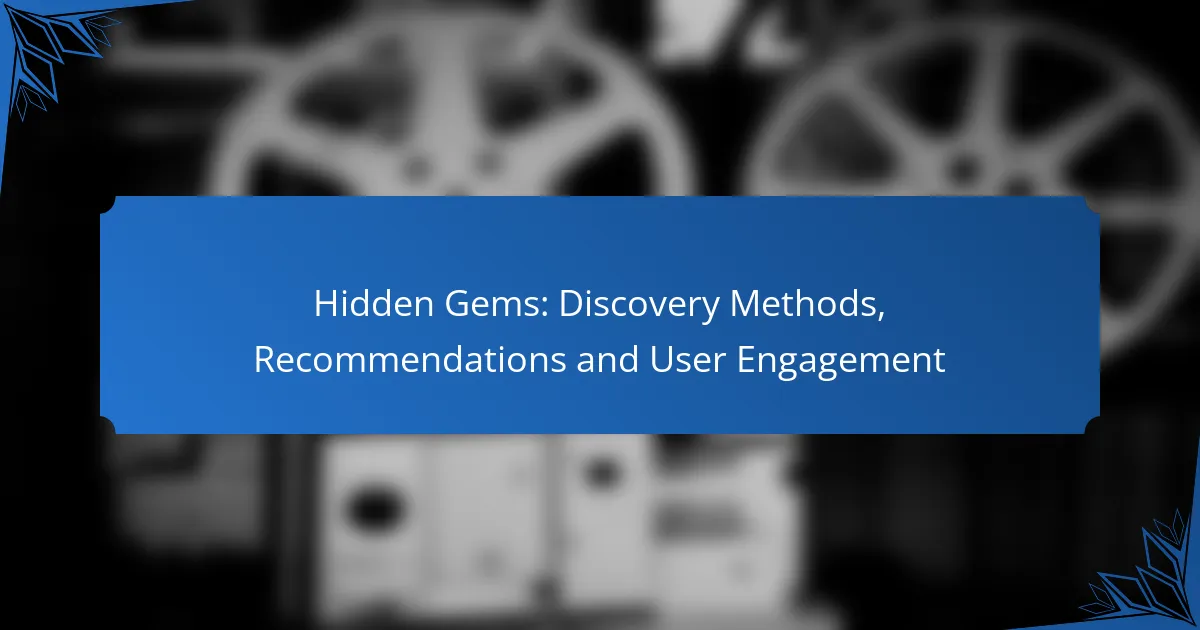Content discovery features play a vital role in enhancing user engagement and improving ad targeting in display advertising. By incorporating personalization algorithms, recommendation engines, and analytics tools, these features not only facilitate content accessibility but also significantly impact usability and effectiveness. Understanding the interplay between user interface design, audience targeting, and content relevance is essential for optimizing the overall user experience and achieving successful outcomes.

What are the best content discovery features for display advertising?
The best content discovery features for display advertising include personalization algorithms, content recommendation engines, social media integration, search engine optimization tools, and analytics dashboards. These features enhance user engagement and improve ad targeting, ultimately leading to better campaign performance.
Personalization algorithms
Personalization algorithms tailor content to individual users based on their preferences and behaviors. By analyzing user data, such as browsing history and demographic information, these algorithms can predict what content will resonate most with each user, increasing the likelihood of engagement.
When implementing personalization, consider the balance between user privacy and targeted advertising. Ensure compliance with regulations like GDPR in Europe, which emphasizes user consent for data usage.
Content recommendation engines
Content recommendation engines suggest relevant articles, videos, or products to users based on their past interactions. These engines utilize collaborative filtering and machine learning to analyze patterns and preferences, offering personalized suggestions that keep users engaged.
To maximize effectiveness, regularly update the recommendation algorithms and test different strategies to see which ones yield higher click-through rates. A/B testing can help identify the most appealing content formats for your audience.
Social media integration
Integrating social media into display advertising allows for broader content distribution and user interaction. By enabling sharing options and embedding social feeds, advertisers can leverage user-generated content and increase visibility across platforms.
Ensure that your social media strategy aligns with your advertising goals. Consider using platforms popular in your target market, such as Facebook or Instagram in the U.S. and TikTok in younger demographics, to enhance engagement.
Search engine optimization tools
Search engine optimization (SEO) tools help improve the visibility of content in search results, driving organic traffic to display ads. These tools analyze keywords, backlinks, and site performance, providing insights that can enhance content discoverability.
Utilize SEO tools to identify high-traffic keywords relevant to your audience and incorporate them into your content strategy. Regularly monitor performance metrics to adjust your approach based on what drives the most engagement.
Analytics dashboards
Analytics dashboards provide a comprehensive view of campaign performance, allowing advertisers to track key metrics such as impressions, clicks, and conversions. These dashboards help identify trends and areas for improvement in real-time.
When using analytics, focus on actionable insights rather than just data collection. Set clear KPIs and regularly review dashboard metrics to optimize campaigns and allocate resources effectively for maximum impact.

How do content discovery features compare in usability?
Content discovery features vary significantly in usability, impacting how easily users can find and engage with content. Key aspects such as user interface design, ease of integration, mobile responsiveness, and accessibility features play crucial roles in determining overall effectiveness.
User interface design
User interface design is critical for usability, as it dictates how intuitively users can navigate content discovery features. A clean, organized layout with clear navigation paths enhances user experience, while cluttered interfaces can lead to frustration. Features like search bars, filters, and personalized recommendations should be easily accessible and visually appealing.
Consider using A/B testing to evaluate different designs and gather user feedback to refine the interface. Aim for a design that minimizes cognitive load, allowing users to focus on discovering content rather than figuring out how to use the tool.
Ease of integration
Ease of integration refers to how seamlessly content discovery features can be incorporated into existing platforms or workflows. Solutions that offer APIs or plugins tend to be more user-friendly, allowing for quick setup without extensive technical knowledge. This can significantly reduce implementation time and costs.
When evaluating options, check for compatibility with your current systems and consider the level of support provided by the vendor. A smooth integration process can enhance user adoption and overall satisfaction with the content discovery feature.
Mobile responsiveness
Mobile responsiveness is essential as more users access content via mobile devices. Features should adapt to various screen sizes and orientations, ensuring a consistent experience across platforms. Poor mobile responsiveness can lead to lost engagement and user frustration.
Test content discovery features on multiple devices to ensure functionality and readability. Prioritize designs that maintain usability on smaller screens, such as larger buttons and simplified navigation menus.
Accessibility features
Accessibility features ensure that content discovery tools are usable by individuals with disabilities. This includes support for screen readers, keyboard navigation, and customizable text sizes. Implementing these features not only broadens your audience but also complies with regulations such as the Americans with Disabilities Act (ADA) in the U.S.
Conduct accessibility audits to identify areas for improvement. Providing alternative text for images and ensuring color contrast can significantly enhance usability for all users, making content discovery more inclusive.

What factors influence the effectiveness of content discovery features?
The effectiveness of content discovery features is influenced by several key factors, including engagement metrics, conversion rates, audience targeting, and content relevance. Understanding these elements helps optimize the user experience and increases the likelihood of achieving desired outcomes.
Engagement metrics
Engagement metrics, such as click-through rates, time spent on content, and social shares, play a crucial role in assessing how users interact with content discovery features. High engagement indicates that users find the content appealing and relevant, which can lead to better retention and loyalty.
To improve engagement, consider A/B testing different layouts and recommendations. For example, using personalized suggestions based on user behavior can significantly enhance interaction rates.
Conversion rates
Conversion rates measure the percentage of users who take a desired action, such as signing up for a newsletter or making a purchase after engaging with content. Effective content discovery features can boost these rates by guiding users toward relevant content that meets their needs.
Focus on optimizing the user journey by ensuring that content is easily accessible and aligned with user intent. For instance, a seamless transition from content discovery to a checkout page can increase conversion rates significantly.
Audience targeting
Audience targeting involves tailoring content discovery features to specific user demographics and preferences. By understanding the audience’s interests and behaviors, businesses can deliver more relevant content, which enhances user satisfaction and engagement.
Utilize data analytics to segment your audience effectively. For example, targeting younger users with trending topics while offering in-depth articles to professionals can improve the overall effectiveness of content discovery features.
Content relevance
Content relevance is critical for ensuring that users find the information they are looking for. Features that prioritize relevant content based on user preferences and past behavior can significantly enhance the user experience.
To maintain high relevance, regularly update your content library and utilize algorithms that adapt to changing user interests. Incorporating user feedback can also help refine content offerings and ensure they meet audience expectations.

What are the prerequisites for implementing content discovery features?
Implementing content discovery features requires a solid technical foundation, adherence to data privacy regulations, and a clear alignment with your content strategy. These prerequisites ensure that the features are effective, compliant, and tailored to meet user needs.
Technical infrastructure
A robust technical infrastructure is essential for supporting content discovery features. This includes having a scalable server environment, efficient data storage solutions, and a reliable content management system (CMS) that can handle dynamic content delivery. Consider cloud-based solutions for flexibility and scalability.
Additionally, integrating application programming interfaces (APIs) can enhance functionality, allowing for seamless connections between different systems. Ensure that your infrastructure can support real-time data processing to provide users with timely and relevant content recommendations.
Data privacy compliance
Compliance with data privacy regulations is crucial when implementing content discovery features. Familiarize yourself with relevant laws such as the General Data Protection Regulation (GDPR) in Europe or the California Consumer Privacy Act (CCPA) in the United States. These regulations dictate how user data should be collected, stored, and used.
Implementing transparent data practices, such as obtaining user consent and providing clear privacy notices, can help build trust. Regular audits and assessments of your data handling practices will ensure ongoing compliance and mitigate potential risks.
Content strategy alignment
Your content discovery features must align with your overall content strategy to be effective. This involves understanding your target audience and their preferences, as well as the types of content you want to promote. Conducting user research can provide insights into what content resonates most with your audience.
Establishing clear goals for your content discovery features, such as increasing user engagement or driving conversions, will guide your implementation efforts. Regularly review and adjust your strategy based on performance metrics to ensure that the features continue to meet user needs and business objectives.

What are the leading platforms for content discovery?
The leading platforms for content discovery include Taboola, Outbrain, and Google Discover. Each of these platforms offers unique features and approaches to help users find relevant content based on their interests and browsing behavior.
Taboola
Taboola is a content discovery platform that recommends articles, videos, and other media based on user preferences and behavior. It primarily operates through native advertising, placing suggested content at the bottom of articles or within feeds to drive engagement.
When using Taboola, consider the types of content that perform well, such as listicles or visually appealing articles. Advertisers can expect to pay on a cost-per-click basis, with rates varying widely based on targeting options and competition.
Outbrain
Outbrain functions similarly to Taboola, focusing on recommending content across various publisher sites. It uses algorithms to analyze user behavior and interests, delivering personalized content suggestions that encourage clicks and engagement.
Outbrain typically offers a pay-per-click pricing model, which can be beneficial for advertisers looking to drive traffic to their content. It’s essential to create compelling headlines and visuals, as these elements significantly impact click-through rates.
Google Discover
Google Discover is a personalized content feed that appears on mobile devices and Google’s homepage, showcasing articles, videos, and other media tailored to users’ interests. Unlike Taboola and Outbrain, Google Discover relies heavily on Google’s search algorithms and user data to curate content.
To optimize for Google Discover, publishers should focus on high-quality, engaging content that aligns with trending topics. Utilizing structured data and ensuring mobile-friendliness can enhance visibility in this feed. Unlike traditional advertising models, content visibility here depends on organic reach rather than paid placements.



